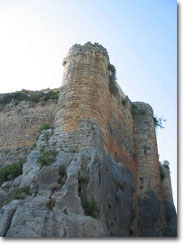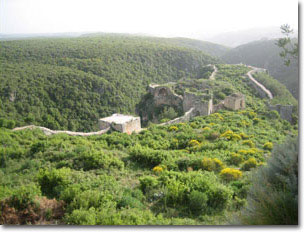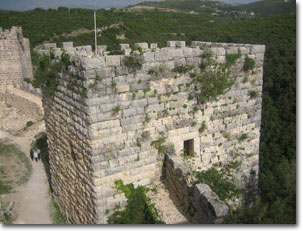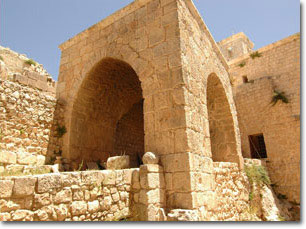|
 24 km
east of Lattakia, lies a huge solid fortress upstanding on the edge of
the gigantic fosse. While its defenses are less intact than studied
symmetry of the Krak des Chevaliers and it is less somber and brooding
in its aspect than Marqab, this is an example of Crusader
castle-building at its most romantic. The castle represents the
flamboyance of the Crusader enterprise - perhaps folly is a better word
- in a raw and beautiful location, softened today by the peaceful
setting and on a spring day, the profusion of wildflowers that cover
the scene. 24 km
east of Lattakia, lies a huge solid fortress upstanding on the edge of
the gigantic fosse. While its defenses are less intact than studied
symmetry of the Krak des Chevaliers and it is less somber and brooding
in its aspect than Marqab, this is an example of Crusader
castle-building at its most romantic. The castle represents the
flamboyance of the Crusader enterprise - perhaps folly is a better word
- in a raw and beautiful location, softened today by the peaceful
setting and on a spring day, the profusion of wildflowers that cover
the scene.
Long before the Crusaders, the site was chosen for its defensive
properties. Its commanding location protected the sweep of the broad
plain behind Lattakia, the reason which probably led to the earliest
fortification by the Phoenicians (early 1st millennium BC) who were holding it when Alexander reached Syria around 333 BC. When the Byzantines moved back into Syria in the second half of the
10th century, the Emperor John I seized this site from the Hamdanid
dynasty of Aleppo and began the first substantial defensive works after
975. It is not known precisely when the Crusaders took it over,
probably in the first two decades of the 12th century. By 1119, the
castle was endowed from Roger, Prince of Antioch, to a local seigneur,
Robert of Saone. In 1188, the castle fell to Saladin, the first major casualty of the
Crusader's fundamental problem, the lack of sufficient manpower to
protect their far flung positions. Confident after his major victory over the Crusaders at Hattin in
Palestine in 1187 which resulted in the Arab recovery of Jerusalem,
Saladin took his army on an expedition to the north to probe Crusader
defenses and block the prospective access route for a fourth Crusade
bent on re-liberating Jerusalem. On 23 July 1188, Lattakia surrendered. 
He moved on the next day to Saone, arriving on the 26th and beginning
his siege on 27 July. Saladin's forces pounded the castle from the
plateau to the east while his son, al Zaher Ghazi, moving in from
Aleppo, took up position across the north ravine. The Crusaders
resisted fiercely but two days later the walls were breached by
bombardment from the mangonels of Ghazi. Muslim soldiers stormed the
breach, gained the lower court and from there swarmed over the narrow
and incomplete ditch into the upper fortress. And that was a new
victory for Saladin. Unlike the major fortresses seized by the Arab leader, Saone did not
lapse back into Crusader hands. It was again occupied in 1280 by a
Governor of Damascus but was regained for the Mameluke Sultan Qalaun in
1287. There were, as a result of continuous occupations, a few
additions to the fortress of Mameluke and Ayyūbid periods, including a
mosque built by Sultan Qalaun. The small town that was in the lower
enclosure was gradually deserted in favor of more convenient locations
once the security of the area assured. The outer line of walls show the transition from Byzantine to Crusader
work. The three relatively slender round towers in the eastern walls
are Byzantine in origin, adapted and strengthened in the Crusader
rebuilding of the 11th century. In the massive square towers to the south, the stone is laid
in large blocks finished with neat boscage detailing in a typically
precise Crusader style. The courtyard flanks the main donjon and one finds the cistern and the
stables in it. In the lower courtyard is the charming Byzantine chapel.
In other parts, there are the Crusader church and another Byzantine
chapel. But the important building to inspect is the mosque with the
minaret that probably date from the time of Sultan Qalaun and the
palace baths that were restored by the end of the 20th century. The palace entrance is marked by a superb gateway in stalactite carving of the 12th century.  
|


